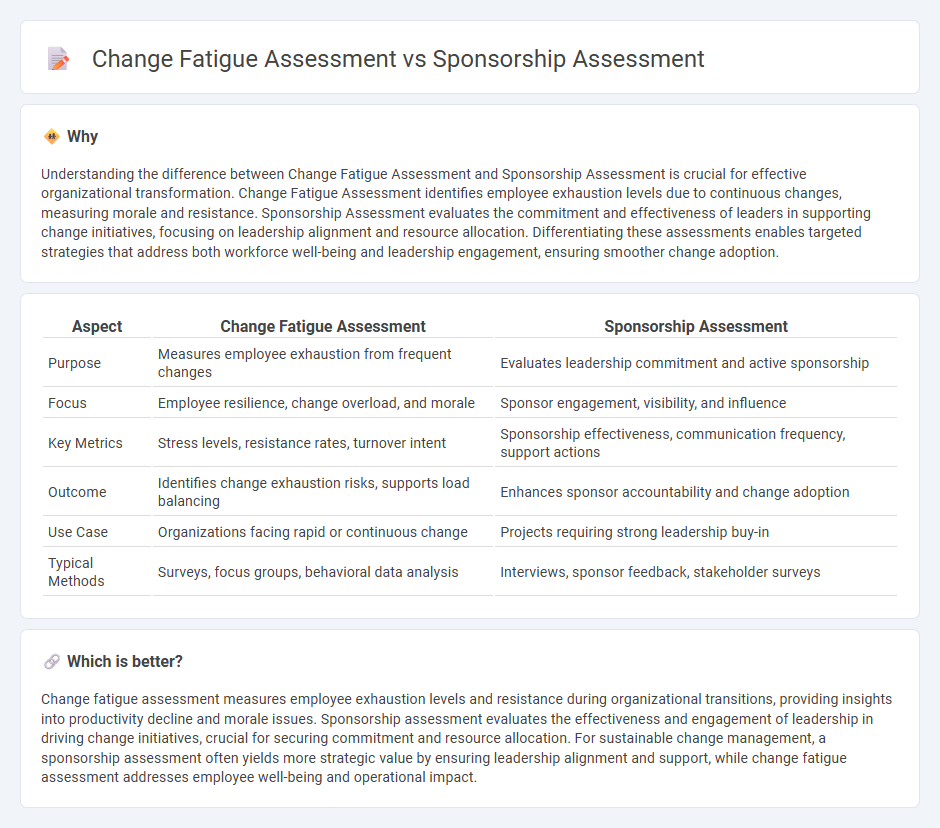
Change fatigue assessment evaluates employee burnout and resistance during organizational transformations to ensure sustainable adoption of new initiatives. Sponsorship assessment measures leadership engagement and support effectiveness in driving change success and accountability. Explore how both assessments optimize change management strategies and enhance transformation outcomes.
Why it is important
Understanding the difference between Change Fatigue Assessment and Sponsorship Assessment is crucial for effective organizational transformation. Change Fatigue Assessment identifies employee exhaustion levels due to continuous changes, measuring morale and resistance. Sponsorship Assessment evaluates the commitment and effectiveness of leaders in supporting change initiatives, focusing on leadership alignment and resource allocation. Differentiating these assessments enables targeted strategies that address both workforce well-being and leadership engagement, ensuring smoother change adoption.
Comparison Table
| Aspect | Change Fatigue Assessment | Sponsorship Assessment |
|---|---|---|
| Purpose | Measures employee exhaustion from frequent changes | Evaluates leadership commitment and active sponsorship |
| Focus | Employee resilience, change overload, and morale | Sponsor engagement, visibility, and influence |
| Key Metrics | Stress levels, resistance rates, turnover intent | Sponsorship effectiveness, communication frequency, support actions |
| Outcome | Identifies change exhaustion risks, supports load balancing | Enhances sponsor accountability and change adoption |
| Use Case | Organizations facing rapid or continuous change | Projects requiring strong leadership buy-in |
| Typical Methods | Surveys, focus groups, behavioral data analysis | Interviews, sponsor feedback, stakeholder surveys |
Which is better?
Change fatigue assessment measures employee exhaustion levels and resistance during organizational transitions, providing insights into productivity decline and morale issues. Sponsorship assessment evaluates the effectiveness and engagement of leadership in driving change initiatives, crucial for securing commitment and resource allocation. For sustainable change management, a sponsorship assessment often yields more strategic value by ensuring leadership alignment and support, while change fatigue assessment addresses employee well-being and operational impact.
Connection
Change fatigue assessment identifies employee resistance and burnout levels caused by ongoing organizational changes, while sponsorship assessment evaluates the effectiveness and commitment of leaders supporting change initiatives. These assessments are interconnected as strong sponsorship can mitigate change fatigue by fostering clear communication, engagement, and resource allocation. Effective leadership sponsorship directly influences the organization's ability to manage employee fatigue and sustain successful change adoption.
Key Terms
Executive Buy-in
Executive buy-in is critical in both sponsorship assessment and change fatigue assessment, ensuring leaders actively support and engage with change initiatives. Sponsorship assessment measures the commitment and effectiveness of executive sponsors in driving change, while change fatigue assessment evaluates leaders' capacity to sustain momentum without overwhelming employees. Explore deeper to understand how executive buy-in impacts successful change management strategies.
Resilience Threshold
Sponsorship assessment evaluates leadership engagement and commitment levels critical to project success, directly impacting organizational resilience thresholds. Change fatigue assessment measures employees' capacity to absorb and adapt to transformations without performance decline, highlighting stress points that reduce resilience. Explore how aligning these assessments can strengthen your organization's resilience threshold and sustain change initiatives.
Stakeholder Engagement
Sponsorship assessment evaluates the commitment and active involvement of leaders in driving change initiatives, ensuring stakeholders receive clear support and guidance. Change fatigue assessment measures the exhaustion and resistance among stakeholders caused by continuous or poorly managed changes, which can hinder engagement and adoption. Explore further strategies to balance sponsorship effectiveness with managing change fatigue for improved stakeholder engagement.
Source and External Links
Sponsorship Evaluation | palowise.ai - Sponsorship evaluation is the process of assessing the effectiveness of sponsorship campaigns by measuring return on investment (ROI) through key performance indicators like brand awareness, audience reach, purchase intent, and sales to optimize future sponsorship strategies and gain competitive advantage.
How Do Sponsors Evaluate Sponsorship Proposals? - Sponsors evaluate proposals mainly based on what is offered and who the proposal is submitted to, focusing on alignment with sponsor needs and the completeness of the business case to ensure the partnership is beneficial and feasible.
12 Steps: Measure and Evaluate Event Sponsorship ROI - Swoogo - Effective sponsorship assessment involves understanding the sponsorship agreement, reviewing contractual obligations, setting clear performance metrics, and tracking budget allocation to measure ROI and improve future sponsorship investments.
 dowidth.com
dowidth.com